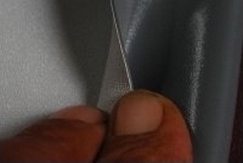The concept
This type of in-ground pool is built directly on the ground, like a natural ornamental pond.
The aim is to waterproof a hole in the shape of your choice, in the ground or in the rock, using a pvc geomembrane, and to be able to keep it filled with clean clear water thanks to filtering systems incorporated in it and joined in a waterproof fashion to the pvc geomembrane.
The aim is to do this economically but to make it very sturdy. (a method for the smoothing of the sides in holes in the rock is described in the manual).
In fact, instead of adding a concrete lining or an assembly of panels in the ground, the ground itself is used for the body of the pool. In this way you have a lot of liberty in the way you shape your pool and there are great savings. The shapes of the pool are sort of sculpted.
Just to say that on stable ground (no fill in) and with a PVC geomembrane (very thick, sturdy liner) of the type usually used for building water reserves of an area of several hectares and with a depth of more than 15 m, you won't have any problems for a good number of years. As there is no fill, the chances of landslip are very small and if anyone did manage to cut the geomembrane in one way or another, you would be able to repair it quite simply with a small off cut or thermoweld it with a heat gun, but when you look at and touch the geomembrane you understand that someone would need to deliberately want to pierce it. This type of thing is already quite a rare occurrence even with a traditional pool liner which is nowhere near as thick.
So, you can do as I have done, a 70m² swimming pool, 2m deep at the deepest point with access steps cut directly into the earth, with submerged beaches, plateau at different levels, an underwater projector and why not an extra water pipe for a future jet or decorative waterfall. The maintenance costs me about 100 Euros per year.
Or simply a cool area 15 or 20 m² large and 1m deep, in which, for example, you have cut some corners, and a seat shape at a good depth to be able to relax in the water, as well as access steps. In this case just one skimmer and one outlet fitting will be enough as well as light filtering. Or why not go above 100 or 120m² , leaving for example, when you dig, a certain area intact to make an island, increase to three skimmers, two or three outlet fittings (their flow is ajustable) and a filtre and a pump with a stronger debit.
Following this principle, anything is possible quite easily. We are all more or less capable for example of cutting steps in the ground or the soil using a pick and spade. It's just a little harder than making a sandcastle. You should understand too that the aim is not to copy my own design as the multitude of shapes dealt with for the pool and for the decking and the decoration, mean that you can instinctively adapt the whole concept to your own creation.
Moreover, the pool, once built, can easily be changed in the sense that several years later, after emptying it, you can enlarge it for little cost, by digging again and by getting the geomembrane welded or sticking yourself another piece of geomembrane or by changing it completely, and possibly adding an extra skimmer and extra outlet fitting. Right from the start think about chosing a pump and a filtre which are a bit bigger, that will mean you do not need to change the material when you alter the pool.
The PVC geomembrane which I used is white (gives water of a blue lagoon colour), micro-ribbed (non-slip under water), and as the under water dirt does not stick, it is easy to clean.


